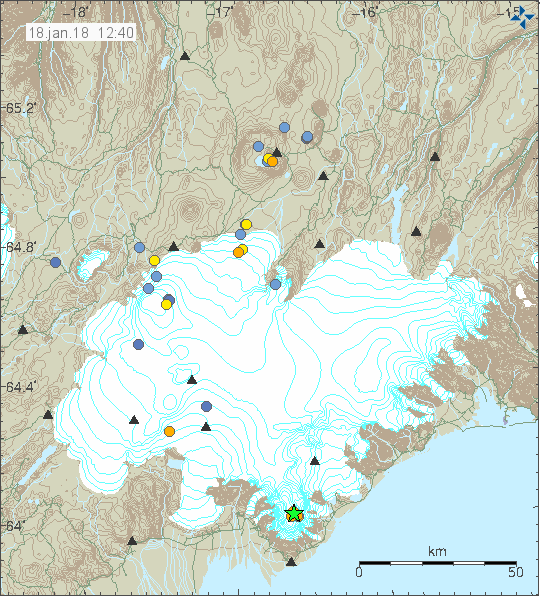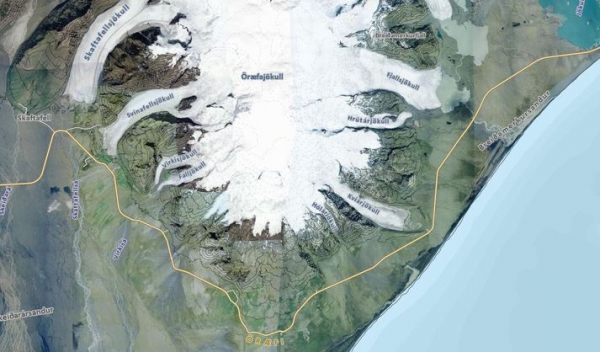A sharp earthquake swarm was detected in one of the powerful volcanoes in Iceland early morning. A 3.1 magnitude quake was detected 2.7 km (1.7 mi) east of Hvannadalshnjúkur peak in Vatnajökull glacier at 2:14 am. Earthquakes are rare in Öræfajökull, the southernmost part of Vatnajökull glacier. Öræfajökull towers over South East Iceland, and is easily visible from Skaftafell visitor center in Vatnajökull National Park.
The summit of Öræfajökull is Hvannadalshnjúkur, the tallest peak in Iceland, standing at an elevation of 2,110 meters (6.920 ft).
Volcano kept under close surveillance

The quake was half a dozen smaller tremors. The Icelandic Meteorological Office reports that the epicenter of the quakes was at a depth of just 100 m (330 ft).
Read more: Emergency evacuation plan in case of eruption in Öræfajökull glacier
Earthquakes are very rare in Öræfajökull. Prior to the current wave of activity the last time a 3+ magnitude quake was detected in the glacier in 2005. Several relatively large quakes of magnitude 3+ have been detected since early October. Scientists have also detected a significant increase in geothermal activity in the volcano's caldera.
While the activity appears to have slowed down somewhat since mid December the volcano is kept under close surveillance.
Read more: Activity in Öræfajökull appears to be slowing down
A terrifying volcano

Öræfajökull covers a giant volcano which last erupted in 1727. A giant steam-blast eruption, also known as phreatic or ultravolcanian eruption, in 1362 eruption in Öræfajökull was the second deadliest eruption in Icelandic history. One of the best known steam-blast eruptions in history is the 1883 Krakatoa eruption. Steam-blast eruptions occur when magma heats ground water, creating a near-instantaneous evaporation and explosion which can eject enormous quantities of ash, rock and volcanic material which is then deposited over surrounding areas.
Read more: Why the constant earthquakes? Iceland is slowly being torn apart
The 1362 Öræfajökull eruption destroyed one of the most prosperous farmland regions in South Iceland, killing all inhabitants and livestock at 20-40 farms in a region which was known then as Litla-hérað. Following the eruption, which deposited 10 cubic kilometers of volcanic material over fields and farms in the region, it's name changed to Öræfi, which translates as Wasteland in modern Icelandic.
The volcano is not particularly active, erupting at an interval of several hundred years. The 1362 eruption is considered to be the largest tepthra eruption in the world in the last 1000 years. The last eruption in 1727-28 was far smaller and caused only three fatalities.
A sharp earthquake swarm was detected in one of the powerful volcanoes in Iceland early morning. A 3.1 magnitude quake was detected 2.7 km (1.7 mi) east of Hvannadalshnjúkur peak in Vatnajökull glacier at 2:14 am. Earthquakes are rare in Öræfajökull, the southernmost part of Vatnajökull glacier. Öræfajökull towers over South East Iceland, and is easily visible from Skaftafell visitor center in Vatnajökull National Park.
The summit of Öræfajökull is Hvannadalshnjúkur, the tallest peak in Iceland, standing at an elevation of 2,110 meters (6.920 ft).
Volcano kept under close surveillance

The quake was half a dozen smaller tremors. The Icelandic Meteorological Office reports that the epicenter of the quakes was at a depth of just 100 m (330 ft).
Read more: Emergency evacuation plan in case of eruption in Öræfajökull glacier
Earthquakes are very rare in Öræfajökull. Prior to the current wave of activity the last time a 3+ magnitude quake was detected in the glacier in 2005. Several relatively large quakes of magnitude 3+ have been detected since early October. Scientists have also detected a significant increase in geothermal activity in the volcano's caldera.
While the activity appears to have slowed down somewhat since mid December the volcano is kept under close surveillance.
Read more: Activity in Öræfajökull appears to be slowing down
A terrifying volcano

Öræfajökull covers a giant volcano which last erupted in 1727. A giant steam-blast eruption, also known as phreatic or ultravolcanian eruption, in 1362 eruption in Öræfajökull was the second deadliest eruption in Icelandic history. One of the best known steam-blast eruptions in history is the 1883 Krakatoa eruption. Steam-blast eruptions occur when magma heats ground water, creating a near-instantaneous evaporation and explosion which can eject enormous quantities of ash, rock and volcanic material which is then deposited over surrounding areas.
Read more: Why the constant earthquakes? Iceland is slowly being torn apart
The 1362 Öræfajökull eruption destroyed one of the most prosperous farmland regions in South Iceland, killing all inhabitants and livestock at 20-40 farms in a region which was known then as Litla-hérað. Following the eruption, which deposited 10 cubic kilometers of volcanic material over fields and farms in the region, it's name changed to Öræfi, which translates as Wasteland in modern Icelandic.
The volcano is not particularly active, erupting at an interval of several hundred years. The 1362 eruption is considered to be the largest tepthra eruption in the world in the last 1000 years. The last eruption in 1727-28 was far smaller and caused only three fatalities.







